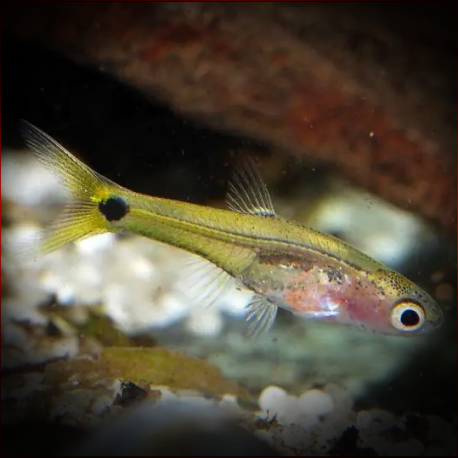More info
Datasheet
| Minimum Tank Size | 15 litres / 3.96 US gallons |
| Maximum Size | 2.0cm / 0.79inches |
| Temperature | 21°C / 69.80°F - 26°C / 78.80°F |
| Hardness | 0.00dgH / 0ppm - 6.05dgH / 108ppm |
| pH | 6.0-7.0 |
General Description
Barboides gracilis, commonly known as the dwarf amber barb, is a miniaturized species of fish belonging to the Cyprinidae family. Displaying a small adult size of less than 2.0cm, this species is native to coastal West and Central Africa, particularly found in shallow, slow-moving rainforest streams and swamps with thick marginal vegetation. The fish typically thrives in clear, slightly brown-stained waters due to low nutrient levels and the presence of tannins from decomposing organic matter, making it an intriguing choice for enthusiasts of planted 'nano' aquaria.
Aquarium Setup
Barboides gracilis thrives in a well-furnished aquarium environment with a preference for slow currents. Ideally kept in a biotope-style setup mimicking its natural habitat, the tank should feature a soft, sandy substrate, driftwood roots, branches for shading, and dried leaf litter to offer cover and stimulate microbe growth. The addition of aquatic plants adaptable to low light conditions, such as Microsorum, Taxiphyllum, or Anubias spp., along with floating vegetation, can enhance the display. Regular, small water changes are advised, and a dimly lit tank environment is recommended for the utmost comfort of the fish.
Behaviour
Although very peaceful, Barboides gracilis is not considered an ideal community fish due to its small size and timid nature. It tends to thrive best when housed in groups of at least 20-30 specimens to reduce nervousness and exhibit more natural behavior. In a group setting, males may display vibrant colors and engage in competitive behavior to attract female attention. It is recommended to keep them with other diminutive species from West Africa or small South American characins for optimal social dynamics.
Feeding and Diet
Presumably feeding on small aquatic crustaceans, worms, and insect larvae in the wild, Barboides gracilis can be picky eaters in captivity. While some individuals may not readily accept dried foods initially, offering small live or frozen fare like Artemia nauplii, Daphnia, and bloodworms is beneficial. Newly imported specimens often require live foods to transition into aquarium life successfully, with dry and frozen foods introduced gradually as they acclimate.
Reproduction & Dimorphism
Mature male dwarf amber barbs are slightly more vivid in body color and slimmer compared to females, especially noticeable during the spawning period. These differences in physical characteristics become more pronounced when the fish are in spawning condition, indicating clear sexual dimorphism.
Habitat and Distribution
Barboides gracilis is primarily found in coastal West and Central Africa, spanning from Benin through Nigeria and Cameroon to Equatorial Guinea. It prefers slow-moving, shallow rainforest streams with dense vegetation along the margins, showcasing adaptations to nutrient-poor environments rich in tannins and organic compounds from decaying plant material.

